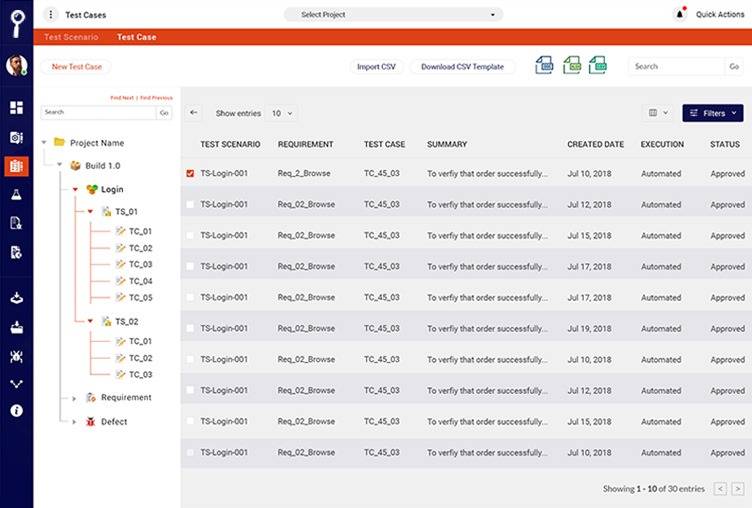If every team member maintains his or her own document version of test cases, then there is a high possibility for them to lose track of the entire test plan and its execution.
The result is patchy test coverage, missed execution of test cases, and poor product delivery.
Keeping test cases in an organized way has big payoffs, especially in medium to large projects.
Further, testing is a repeatable process. Re-using test cases saves time for everyone. Projects have large parts that can be repeated for testing. Maintaining a test case repository allows you to reuse previous test resources wherever needed and speed things up. The good news is maintaining an organized test case repository is not even difficult!
Success of a software testing team is generally associated with the volume and nature of test cases that form the basis of testing cycles. It may require a tremendous amount of time and attention to the assimilation of test cases, with the primary focus locked on establishing a comprehensive test case repository for each application.
Test repository comprises test cases that encompass all key possibilities of permutations and combinations in workflow execution and transaction, ensuring that all variations in system and user interactions are covered.
A test case repository is not just confined to variations in system and user interactions but also caters to:
- Different target configurations spanning form factors, databases, operating systems, hardware platforms.
- Changes in software releases and versions that should be forward and backward compatible.

Source: Harvard Business Review
Let’s have a closer look at why the test repository is a good first step and how it can be helpful for groups observing lean test management.
Overall waste reduction
The biggest value of lean methodologies in software testing is that they help organizations improve the reuse of available resources by mitigating waste. Experts believe that old testing processes are often focused on the documentation of each testing effort and running tests again at the end of each release–to ensure that new work didn’t impact the previous functionality. However, this approach is problematic as it requires writing and maintaining test cases demanding more costs, time, and effort.
In a modern test management tool, a test repository crops up as you write test cases and keep associating with requirements. It is a live working document that is embedded in your project in a granular way. QA teams can write tests once and easily access them for future use. Moreover, testers can ensure seamless automation and execute tests as per requirements without needing manual approval for each interaction. This gives the QA professional enough time to focus on other critical areas and assure that the project is fully supported as required.
Moreover, as a test case repository grows with time, testers should keep it current with every update to the business application or software product. If this is not done, then it loses synchronization with the actual function and behavior of the software over time. This consequently degrades the results produced in future QA cycles.
Below snapshot shows an example of a well-organized list of test cases. Each test case associated and grouped neatly in test scenarios and requirements. A good test repository app provides detailed dashboards such as this for quick tracking of previous test assets.

Boost application quality and knowledge
Test repository plays a vital role in ensuring that each system component is fully evaluated and hidden defects are identified quickly. Studies suggest that the key to achieving a successful and smooth project execution is possibly the maintenance of system documentation which includes a test repository.
If the code does not pass the test case in the very first run, QA teams can leverage the repository to locate if certain areas of the software are more prone to errors than others, and then take a systemic approach to fix the whole branch. Testing efforts are reduced with a maintained central repository containing extensive data for all kinds of testing.
A unified platform will be less expensive and more accessible than one dedicated to each group or project, helping to boost overall quality and keep everyone on track.
Standardizing processes
We often see teams leveraging different procedures depending on the project but this may not be the most efficient way. Lean testing helps standardize processes and keeping a repository can further boost this initiative. Storing unwanted and excessive data can make retrieving appropriate information a challenging task. But with the help of lean practices, teams can easily refresh tests to reflect the most current trends.
Depending on the frequently used datasets, you can easily eliminate obsolete data to ensure the presence of new and quality data. This reduces the costs to store unnecessary data. Additionally, having different versions of the repository can greatly help in regression testing to identify what changes in data can break the code.

Source: Transforming Data With Analytics
Significance of test case repository tools
Imagine the need of tracking your development and testing progress but having no singular source. In this regard, choosing the right test case repository tool that is versatile and performs according to the project requirements is perhaps very important.
Test repository tools, like offered by Kualitee, can help you leverage your lean testing in the following ways:
- Create an organic test case repository without additional effort for documentation.
- Align your test cases according to your requirements and modules for ease of use.
- Manage manual and automated test cases from one place.
- Keep track of their execution records.
- Check ownership of creation and editing.


























